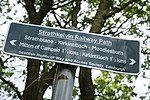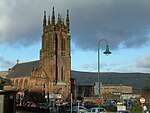Milton of Campsie railway station
1848 establishments in Scotland1951 disestablishments in ScotlandDisused railway stations in East DunbartonshirePages with no open date in Infobox stationRailway stations in Great Britain closed in 1951 ... and 3 more
Railway stations in Great Britain opened in 1848Scotland railway station stubsUse British English from March 2022
Milton of Campsie railway station served the village of Milton of Campsie, in the historical county of Stirlingshire, Scotland, from 1848 to 1951 on the Campsie Branch.
Excerpt from the Wikipedia article Milton of Campsie railway station (License: CC BY-SA 3.0, Authors).Milton of Campsie railway station
Birdston Road,
Geographical coordinates (GPS) Address Nearby Places Show on map
Geographical coordinates (GPS)
| Latitude | Longitude |
|---|---|
| N 55.9621 ° | E -4.1617 ° |
Address
St Paul's
Birdston Road 16
G66 8BU
Scotland, United Kingdom
Open on Google Maps





